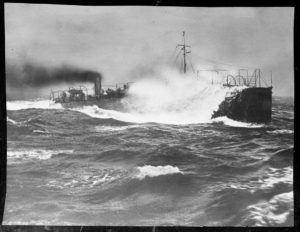A few years ago when I did my very first brew day, I chose two different beers (“extract with specialty grains”) to take the plunge into brewing. I chose a pilsner, which as a beginner, was probably the worst choice I could have made. The other kit was a clone of Samuel Smith’s Tadcaster Porter (Taddy Porter for us beer
Samuel Smith’s Taddy Porter is an English Porter (BJCP category 13C) and is listed in the commercial examples for the style. It is also one of the only examples you will be able to find just about anywhere in the United States (Fullers London Porter is the other – and also really nice), and the first British Porter I ever tried. What I liked about Taddy Porter so many years ago (more than 20) was the rich and slightly bitter taste. I never could put my finger on how the taste of Taddy Porter was so different until many years later. That first clone kit contained the base extracts, specialty grains, and some good old English Fuggles for hopping. What it also contained was a small vial of blackstrap molasses. Pow! The lightbulb went on instantly; that was the flavor component that made Taddy Porter so delicious. My first brew day went well (if not too long), and a few weeks later I kegged my knockoff porter, and it actually turned out pretty nice.
Fast forward two years, and I am neck deep in all-grain brewing with computer programs, temperature controlled everything, and a brewery storeroom where my dining room used to be. I took that original kit recipe, converted it to all-grain (thanks to BeerSmith), and then started making the tweaks. I did several versions of this porter, which I refer to as BSP at Sea. For the non-Navy types out there, BSP stands for “Brief Stop for Personnel,” on which every sailor wished we could be getting beer, vice people.

Brief stop for personnel
The BSP tag also had a second meaning. I was adding a lot more black strap molasses to the recipe, and the beer was quickly becoming “Black Strap Porter” around my house. We tried doing both carbonated and beer gas (Nitro) versions, and they were okay, but not great, in my opinion. Lots of people raved about the beer, but I always thought it was missing something, so I went back to the drawing board to try to get more flavor. I tried using some smoked malt to deepen the flavor and increase the complexity. I did like the result, but I still thought the overall malt bill needed some work. I submitted the smoked (and nitro) version in the Ocean State Homebrew Competition, just to get the feedback, and it got killed in the scoring with 24 of a possible 50 points. This was not great, and to be honest, the nitro ruined it for bottling. Once again, I looked to the drawing board and the malt bill to figure it out.
I began listening to The Brewing Network podcasts about a year ago and had listened to every beer conversation I could. Once again, I turned to Brewing with Style and Jamil Zainesheff for inspiration. I took his robust porter recipe, tweaked it for my own system, and brewed it in May 2015 under the name Pogy Porter. The key to this new recipe was taking the advice to not use the Irish Ale yeast I had been using and to use California Ale yeast (WLP001 from White Labs). The idea was that I should be brewing a robust porter in the American style and not trying to duplicate Irish/English yeast profiles with an American style malt bill. Fermentation went as expected (1.056 to 1.014) and I stored the beer in a carboy under CO2 blanket from May to October. I then kegged it at 12.5psi for a week to see what this new base recipe turned out like. At 5.7%ABV it was really drinkable, and the second I put it on tap at my house (and tailgating) it became a hit. The malt bill was obviously the reason it tasted more complex; the yeast helped by letting the malt be the star. My malt bill for this porter (Pogy Porter):
- 8% Maris Otter (3 L)
- 5% Crystal 40 (40 L)
- 5% Munich II (8.5 L)
- 8% Chocolate malt (350.0 L)
- 4% Black Patent (500 L)
This grain bill was the start of my revamp of BSP at Sea, which then received a few tweaks by adding some smoked malt, British pale chocolate malt, and the black strap molasses. This new malt bill for BSP at Sea:
- 7% Maris Otter (3 L)
- 7% Cherrywood smoked malt (2 L)
- 7% Crystal 40 (40 L)
- 7% Munich II (8.5 L)
- 3% Chocolate malt (350.0 L)
- 3% Pale chocolate malt (215 L)
- 2% Black Patent (500 L)
- 8oz black strap molasses
The objective is to add even more complexity by adding the smoked malt and molasses, but I am also hoping to get the additional flavor/complexity from adding pale chocolate as well. The Original Gravity (OG) going into the fermenter was 1.059 and we are shooting for a Final Gravity (FG) of 1.012-1.014 for and ABV of 6-6.2%.
Beer is just like any other living thing. You make plans, nurture it, and watch it effectively “grow up,” all the while you never really know how it will turn out until that first glass. In two weeks, we will be moving our experiment to secondary fermentation and aging for a few weeks. During the Christmas Holidays it should be on tap and we will be filling a few bottles for competition to see if we can improve on that 24-point score.

